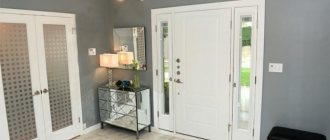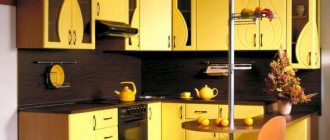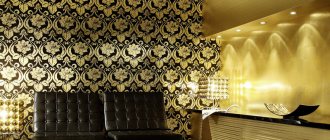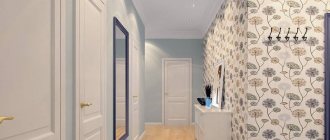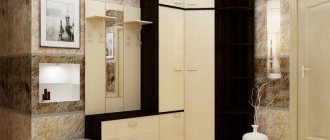Paintings, photographs, posters and panels have always served as the main decorations of any interior. It would seem that a beautiful picture is good in itself, regardless of the environment and location, however, in practice this statement is not always true. Do you always need picturesque masterpieces for interior decoration, or can you get by with “little blood”? Which wall in the room should I choose for hanging pictures? How to correctly arrange and arrange several photographs or drawings into a single composition? What height is best to hang them? We will try to answer all these important questions in detail.
On the wall you can place not only oil paintings, but also mirrors, reliefs or your favorite collection of drawings and postcards, the main thing is to choose a decent frame for them, Ballards Designs
Decor and accessories in the interior play an important role, creating the integrity of the image and the atmosphere of a cozy and lived-in space. Even when the decoration is completed and the furniture is in its place, the walls of the room often look too empty and boring, and that’s when the need arises to decorate them with paintings, posters, etc. It’s great if you already have several paintings or graphic paintings worthy of decorating the interior, however, if you don’t have a collection of works of art, this is not a reason to leave the walls empty. Family photos in neat frames, digital printing of any image on canvas, interior collages that you can make yourself, etc. may well become an original and stylish replacement for familiar paintings. In addition, the canvases, which in themselves are not masterpieces, united on the wall in a common group, create a completely attractive and interesting composition, which can be given a certain rhythm or used in the interior as a missing color accent.
Vintage and not so old maps can also be an interesting option for room decor, Pottery Barn
Tip: if you want to adjust the size of the image, use a mat. With its help, for example, you can make a small drawing appear larger.
Geometry and function of the room
The composition of hanging paintings in the interior is directly influenced by the geometry of the surrounding space, while paintings on the wall can visually correct the shortcomings of the room. So, for example, paintings placed vertically can make the ceiling appear higher, while, on the contrary, those hung horizontally can make the ceiling appear wider. If the task is to make a narrow and long room seem shorter, it is enough to place one large and bright painting on its end wall.
Human perception is extremely sensitive to horizontal lines, so when building a composition from several images, try to ensure that their lower part lines up horizontally.
Paintings and photographs can not only be hung, but also, for example, placed on shelves; however, this option is not suitable for interiors in a strict, classic style
The function of the room also plays an important role. Decorators do not recommend placing large and bright canvases in the bedroom, just like dramatic and battle images, which will undoubtedly interfere with rest and relaxation.
An original option for placing a painting on an easel, Pottery Barn
Advice: if you are not sure how a particular canvas will fit into the interior, place it first on a music stand or easel and see how it will fit with the decor. The same technique is suitable for placing paintings in rooms where, due to some circumstances, it is impossible to damage the walls and drive nails into them.
Helpful Hints and Advice
Everything in the interior should be in harmony. Ancient painting is more suitable for the classical style, avant-garde looks better among laconic minimalism, and landscapes are suitable for the Provence style.
The color of the baguette should match the color of the furniture in the room.
Particular attention is paid to the choice of baguette. The function of the frame is to connect the picture with the interior. This is a kind of connecting link that emphasizes the sophistication and beauty of the canvas, placing emphasis on it, but at the same time does not stand out from the general style of the entire room. For each visual technique, a certain type of baguette is used. Modern paintings are usually framed in colored smooth frames, graphics are most often placed on a mat, ancient paintings are framed in massive classic frames.
If it is necessary to emphasize the picture in the dark, then it is additionally illuminated. To do this, it is most convenient to use a spotlight designed for each canvas separately. It is necessary to very accurately calculate the angle of illumination to avoid shadows and glare.
The canvases should be positioned on the wall in such a way that they are easy to admire.
The height from the floor must be selected so that the middle of the picture is at eye level. If, as planned, there will be a collage of several works on the wall, then you need to determine one common line. Small paintings are hung one above the other so that the space between them is at eye level. You can make a beautiful composition out of them by gathering them around one large one.
The best posts
- Which finishing putty is best and how to apply it?
- DIY LEDs for cars
- Cost of paving slabs and their installation per 1 m2
- Original DIY hanging shelf for wine and glasses
- Cement crafts for the garden: more than 20 ideas, instructions and master classes
- How to make a driftwood for an aquarium with your own hands in five steps
- How to make a jelly rag (velcro for dust) for cleaning with your own hands
- Features of laying parquet boards
Related article: Wallpaper-related materials
Height
It is important to choose the right height for hanging paintings so that they are clearly visible. In this case, you need to focus on an imaginary line passing exactly through the center of the picture. The classic, “museum” version of hanging paintings is 152 cm from the floor to this midline. When placing a group of paintings, accordingly, it is necessary to take into account the height of the frames, the passport and the spaces between the paintings. Thus, the center of the picture should be located just below the eye level of a standing person (that is, at approximately 150 cm). Small paintings and photos can be hung a little lower so that they are easy to see, larger ones - higher, approximately at a height of 160 cm from the floor.
Reminder: it is better to hang paintings in the dining room and kitchen a little lower, since you will most likely admire them not standing, but sitting at the table.
Asymmetrical composition of paintings of different formats
If you do not plan to place a large canvas or poster directly on the floor (a decorative technique sometimes used with modern paintings and graphics), hanging pictures below 60 cm is not recommended.
Relationship with furniture
The paintings in the interior are not part of an empty museum space with white walls, but complement a room already filled with a variety of pieces of furniture with which they should organically interact. When hanging pictures, you should pay attention to the presence of protrusions and niches, the level of the top edge of doors and windows, and the position of the furniture.
Simple drawings or ornaments, which almost anyone can repeat, can organically decorate the interior. An example of a symmetrical composition of works of the same format, Pottery Barn
Tip: it is not recommended to hang pictures next to tall cabinets, but a large picture even above a small fireplace portal will look very impressive.
The classic option for placing paintings in the living room is above a sofa or other large but low piece of furniture
Most often, paintings are grouped on one of the walls of the room, for example, above a fireplace, a low chest of drawers or a sofa. In this case, it is important to draw an imaginary line from the edge of the piece of furniture, and position the picture in such a way that there is free space between them and this line.
Composition
As already noted, even the simplest images can become an impressive addition to the interior if combined into a single composition and positioned correctly. The number, size and format of paintings can be completely arbitrary, which, in turn, makes the task of arranging them even more difficult. You can group paintings by technique (for example, watercolors or engravings), color scheme (for example, black and white photographs), and theme (animal prints or still lifes).
Option for a symmetrical composition above the sofa
Reminder: if you do not want to turn the room into a museum hall, it is better to choose only one of the walls to place paintings.
Some decorative panels can be placed both vertically and horizontally, Improvements
How to choose the right paintings
The choice depends on several factors. Let's look at them in more detail:
- frame size . When choosing a frame, it is important to make sure that it complements the painting and does not compete with it. The picture should be dominant. It will be a kind of connecting link in the style of the living room;
- color solutions . The color scheme of the picture must necessarily overlap with the furniture. The delicate and discreet interior of the living room needs it. It can be made in light pastel colors. Whereas a room with bright red furniture will force you to use drawings in the same colors. Her palette should be catchy, and maybe even aggressive;
- materials for making drawings . Depending on the type, they can be painted on canvas, or even on newsprint.
It is recommended to combine the colors of the painting with the decoration of the walls and upholstery of upholstered furniture.
Contemporary art uses all the possibilities for creativity.
Modern style can do without frames at all. Objects of art are hung without them. Modular options are welcome.
Options for grouping paintings into a single composition:
- paintings of approximately the same format and size can be hung in a symmetrical “grid”, that is, identical canvases are hung in one line with equal spaces between them
- small images can be grouped around a larger picture, or lined up on the same axis, while the larger image is shifted from the center of the composition to the left or right by about 30 cm
- if you have two images of different sizes, the larger one can be hung a little higher to make it easier to perceive (the center of the pictures, in this case, will coincide)
Backlight
An important aspect of the perception of paintings in the interior is their illumination. Of course, it is not always possible to illuminate each painting individually, so it is better to initially choose a well-lit part of the room for hanging paintings. The most valuable and attractive items in the collection can be illuminated separately, using, for example, frames with built-in lighting or special lamps. For illumination, experts recommend using halogen light bulbs, since their white light does not affect color perception. The lamps should be directed directly at the canvas, adjusting their position until all unnecessary reflections and reflections disappear from it.
Special lamps for illuminating paintings usually have an elongated shape and are located above the frame, Lucifero's
A few bright posters, collages or stylish photographs can really transform the appearance of a room, even without the expense of major renovations. Feel free to experiment with interior decor to give your home a unique personality and highlight your style.
Types of paintings for the interior
It is clear that not everyone can purchase a real painting painted by a famous artist. But it can be quite successfully replaced by reproduction. Authenticity is not as important for the interior as the content of the image, which, together with the palette of shades, should fit harmoniously into the overall interior of the room and evoke only positive emotions.
Modular pictures
More recently, modular paintings have come into fashion, which consist of individual parts or segments, in other words - segmented paintings. Each segment is interconnected with the neighboring one, and all of them as a whole add up to one plot and theme. Such paintings add originality and sophistication to the interior. The number of segments can be anything. Such paintings decorate not only the interior of the living room, but also the walls of offices, restaurants, and cafes. Modular paintings provide a huge selection of styles and trends in fine art. It can be both landscape and abstraction, avant-garde and other directions. Let's take a closer look at some of them.
Abstraction in paintings
By using an abstract painting to decorate the walls, you will bring a bright, extraordinary element to the interior. An unconventional plot and strange images will become a real and unique decoration for any room, because such paintings are created in a unique style, and therefore they can be specially selected for any room, be it an office, a bedroom or a kitchen. Such paintings help create the desired style in the room.
It is important to know that when choosing paintings for the interior of a room, it is necessary to show a sense of proportion so that the room does not turn into an art gallery.
Posters in the interior
Many people mistakenly believe that posters are paper posters depicting famous artists. In fact, this is not true at all. The poster can depict everything: from show business stars, animals, nature, to inscriptions and slogans or personal photographs. It is also an erroneous statement that posters are printed on thin paper and are very short-lived. In fact, the image can be applied to thick paper, close to real canvas, or to photographic paper. Modern posters are close in quality to expensive luxury paintings. Their main purpose is to decorate part of the interior of the room, although sometimes they perform advertising, informational and commercial functions in offices and other premises.
Related article: What to plant at home? 10 most popular indoor plants



